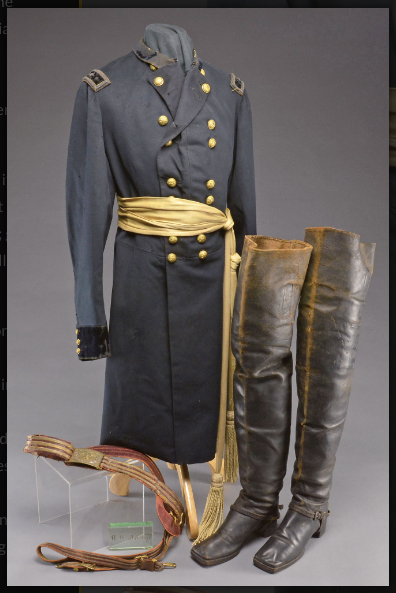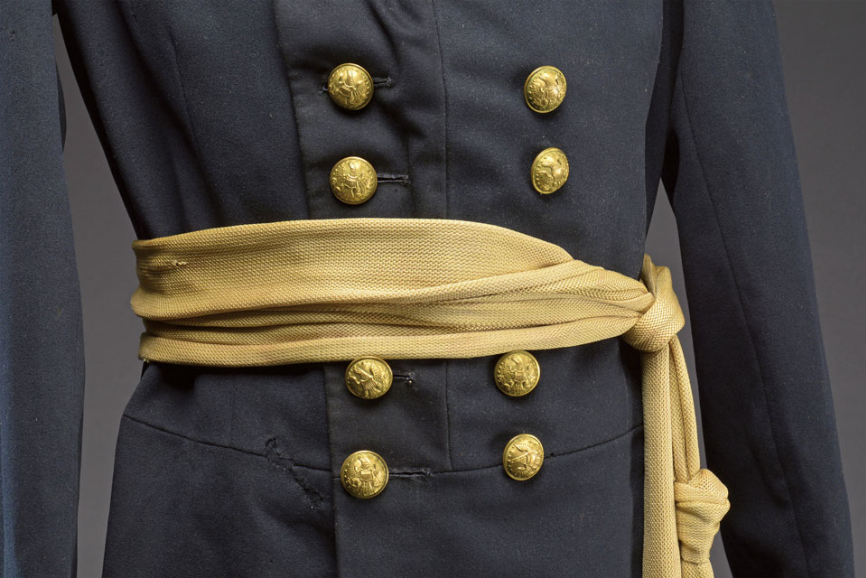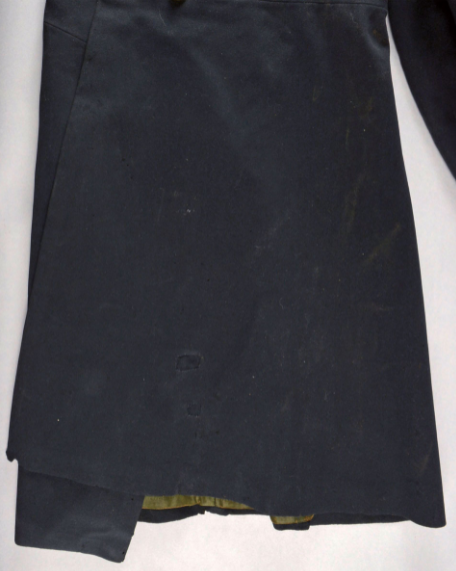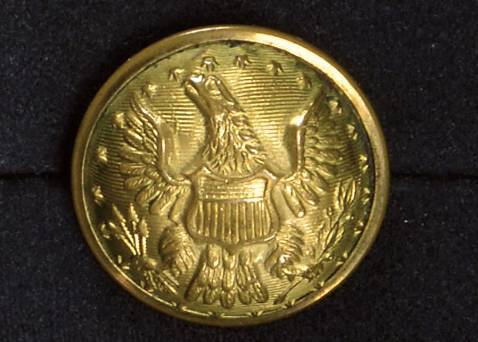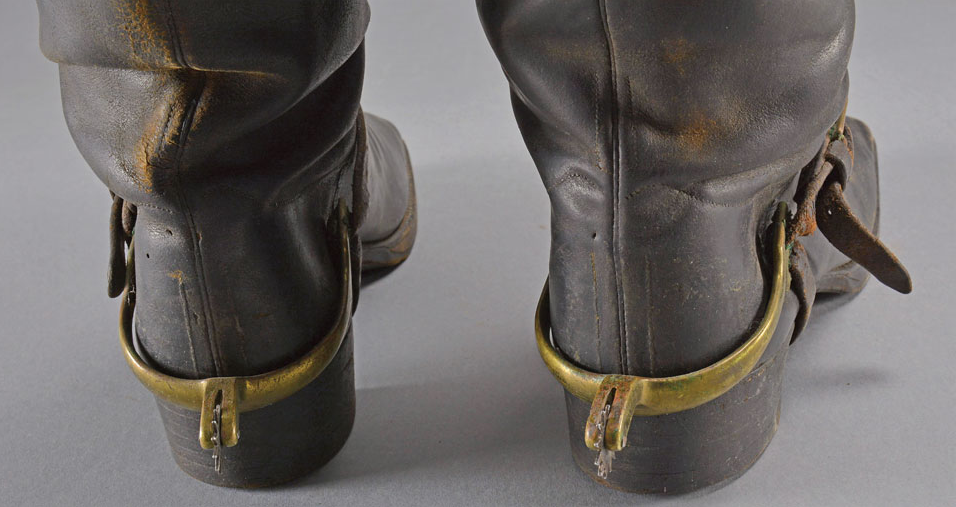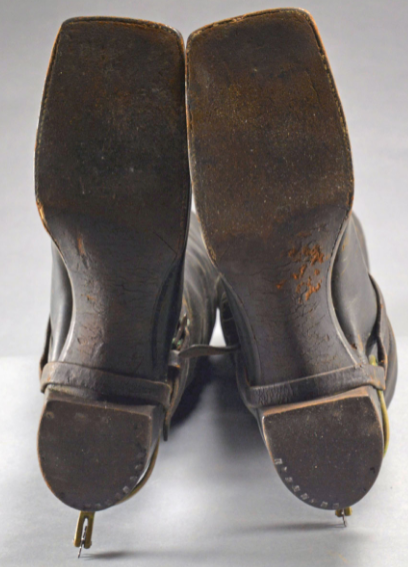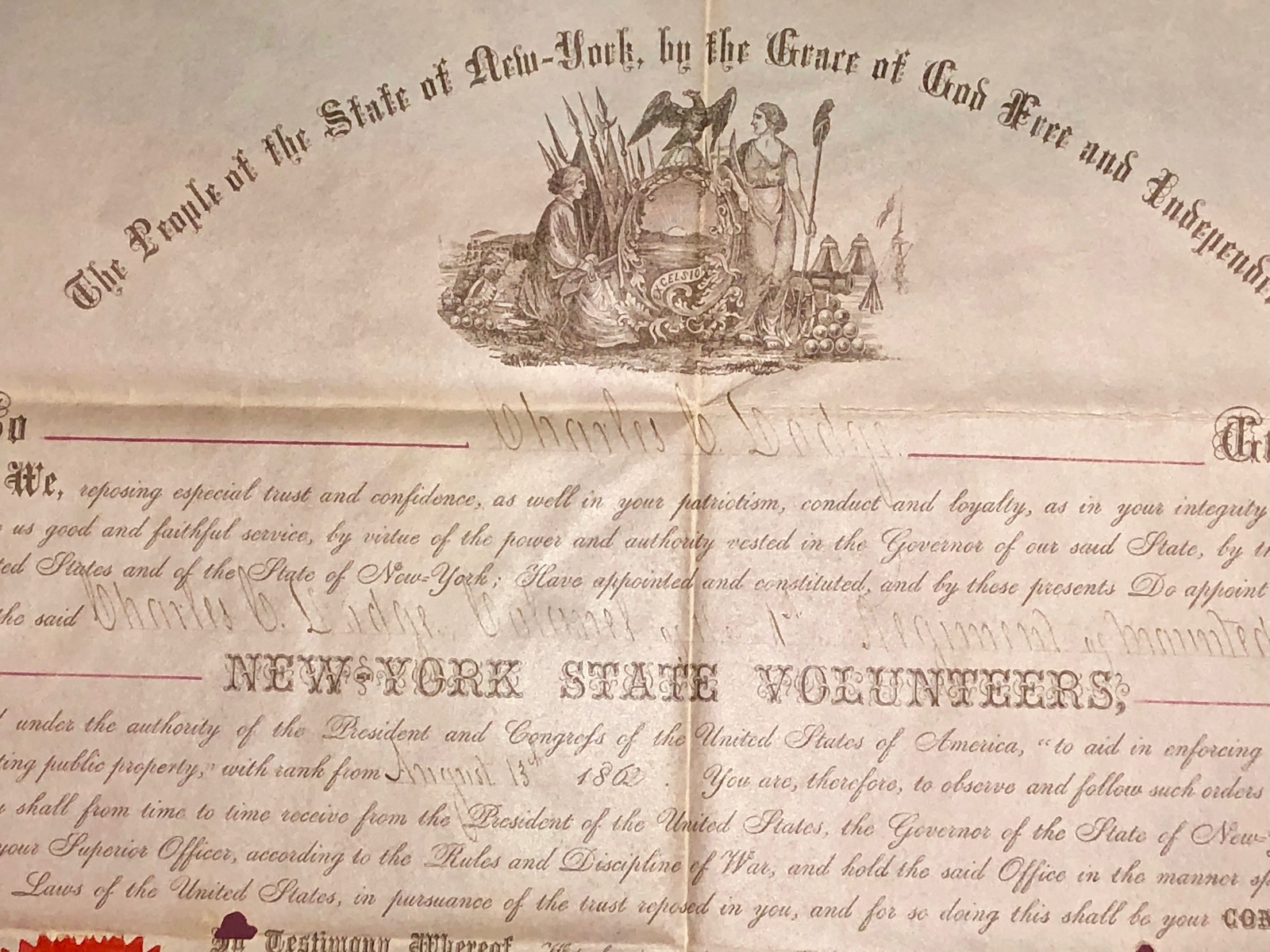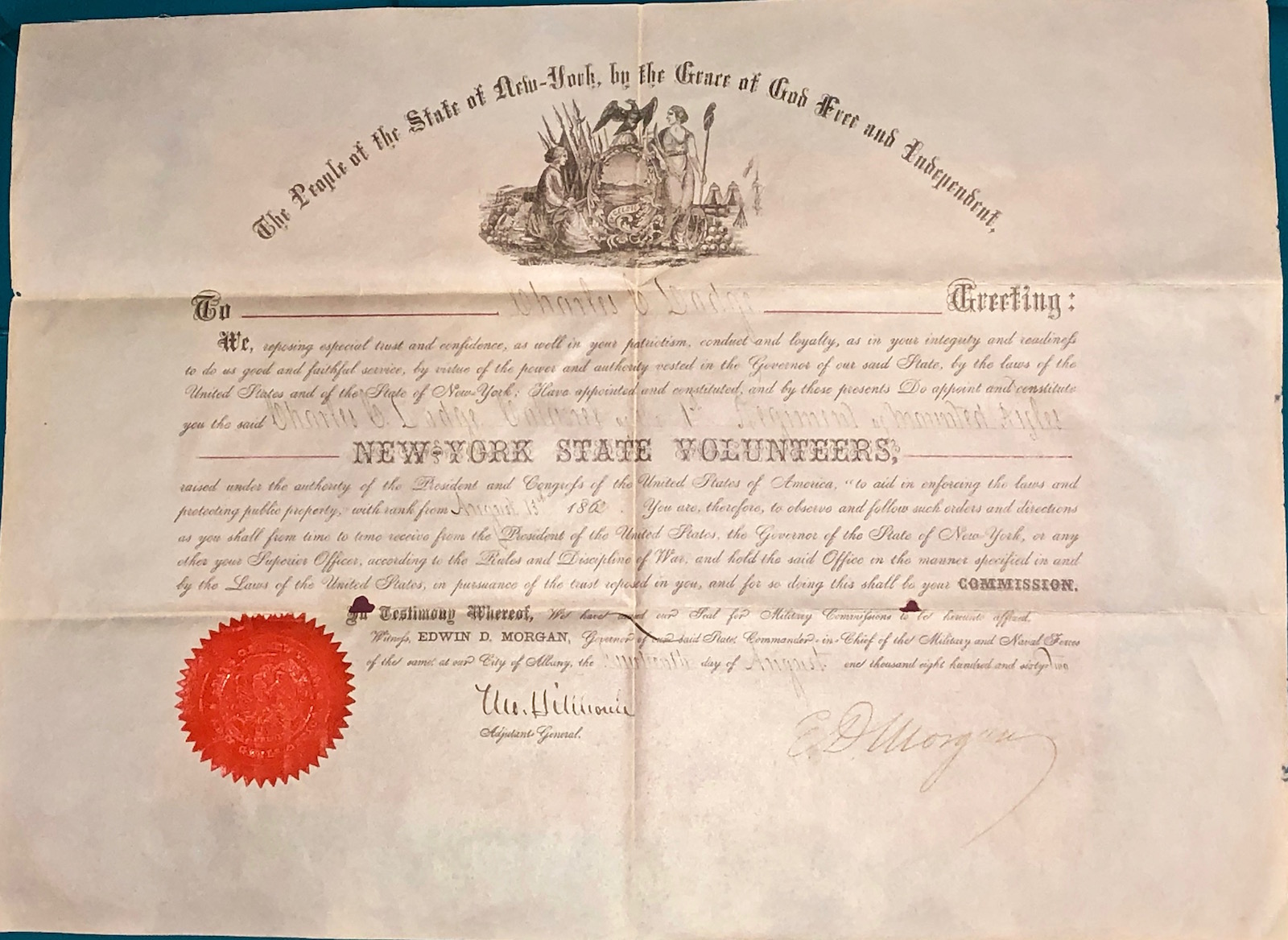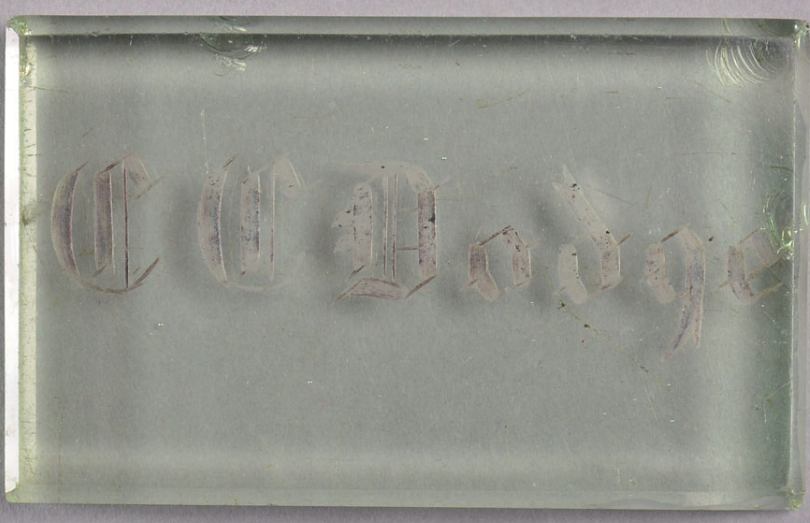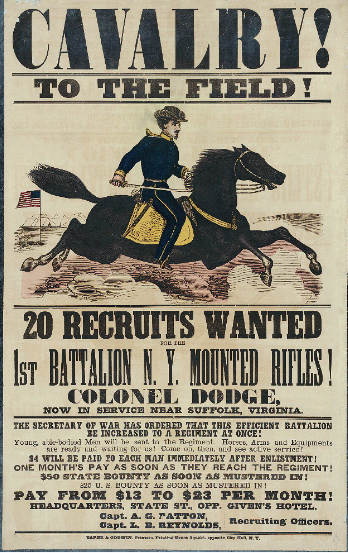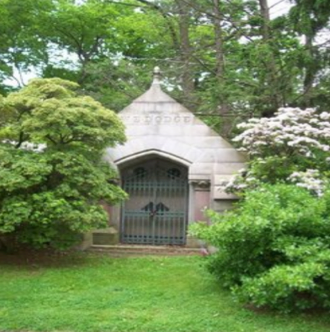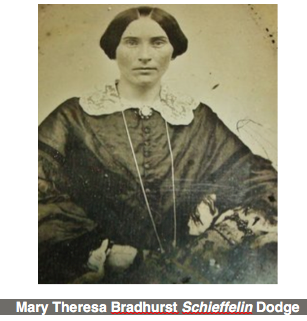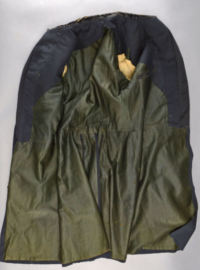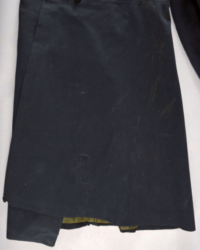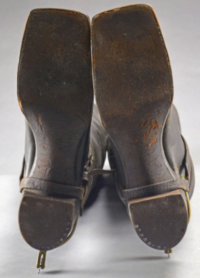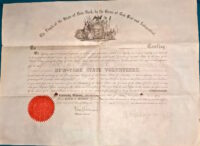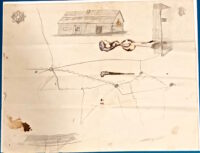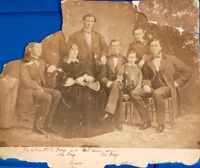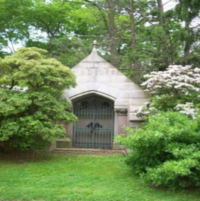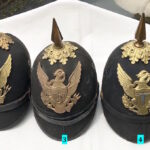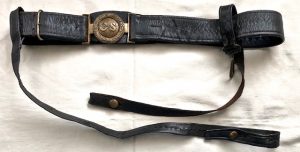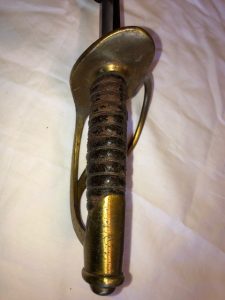IMPORTANT UNION BRIGADIER GENERAL CHARLES C. DODGE’S FROCK COAT, ACCOUTREMENTS & ARCHIVE
SOLD
IMPORTANT UNION BRIGADIER GENERAL CHARLES C. DODGE’S FROCK COAT, ACCOUTREMENTS & ARCHIVE – Col. Charles Dodge, at the age of 21, was promoted to the rank of Brigadier General on November 29, 1862, after just over a year in service, thereby making Dodge the youngest full Brigadier General, in U.S. Army history. A number of prominent citizens, including Theodore Roosevelt, Sr, recommended Dodge for his promotion. Dodge would always be the youngest American Cavalry General, as G.A. Custer would not attain the rank of General until he was 23. Uriah G Pennypacker, in 1865, was the only commissioned general, during the Civil War, appointed at a younger age, although his appointment was a novelty, as he was brevetted, on the field, January 15, 1865, in anticipation of his imminent death. Pennypacker would survive and was given a full brigadier commission, April 28, 1865, after Lee’s surrender.
General Dodge’s regulation, double-breasted general’s frock coat retains all of its original buttons and original rank straps. The coat is a well-tailored frock coat, with velvet collar and cuffs and matching velvet backgrounds on the Brig. General straps. The coat exhibits all of the typical characteristics that you want to see in an early Civil War officer’s frock coat: “balloon” elbows, functional cuffs, green satinette lining, off-white cotton sleeve linings, brown polished cotton lined tail pockets, deep blue indigo dyed English broadcloth wool for the exterior coat body, un-hemmed skirt bottoms, lengthy skirts. Accompanying the frock coat is Dodge’s buff-gold, general’s sash and his colorful saber belt (which is constructed of red Moroccan leather and gold bullion, heavy gauge wire) and belt plate – an unusual, high relief, M1851 cast brass officer’s plate, with the wreath and stars individually silvered; the belt plate safe exhibits a gold embossed label of the late war maker – Baker & McKenny. General Baker’s cavalry boots, rare examples of the impressively tall and highly squared toe variety, are 30” tall and have his original spurs still attached. Two ostrich feathers or plumes, assumedly from Dodge’s hat, are included.
Additionally accompanying this fine grouping are the following: Dodge’s typed manuscript, with his corrections and additions, of his war time career; several wartime letters and covers; a thick glass paper weight, etched with Dodge’s name; a war time sketch, by Dodge, of two cabins that were aspects of Dodge’s regiment’s camp in the Suffolk, Va. area; his appointment to Colonel, on velum, signed by the Governor of New York; a large albumen image of pre-war vintage, depicting the Dodge family.
Condition: The frock coat remains in overall very good condition, with definite signs of field wear and a couple of small holes, on the tails. The sash is in excellent, strong condition, as are the boots and spurs. The belt remains in very good condition, with one weak area. All ephemera is in good condition, with the exception of the large, family image – it has some significant loss along the edges of the image.
Charles C. Dodge
| Born | September 16, 1841 Plainfield, New Jersey |
| Died | November 4, 1910 (aged 69) New York City |
| Place of burial | Woodlawn Cemetery (Bronx, New York) |
| Allegiance | United States Union |
| Service/branch | United States Army Union Army |
| Years of service | 1861–1863 |
| Rank | Brigadier General |
| Commands held | 1st New York Mounted Rifle Regiment |
| Battles/wars | American Civil War |
| Other work | Businessman |
.Charles Cleveland Dodge (September 16, 1841 – November 4, 1910) was a brigadier general in the American Civil War and one of the youngest in history, receiving his commission at the age of twenty-one. He was the son of Congressman William Earle Dodge.
Dodge, Charles C., brigadier-general, was born in Plainfield, N. J. Sept. 16, 1841. He was commissioned captain in the first N. Y. mounted rifles, Dec. 6, 1861, and was soon afterwards promoted major. He was in command of the outposts at Newport News, and of a cavalry column of Gen. Wool’s army that marched on Norfolk, and received the surrender of that place before the arrival of his superior officers. He commanded in successful engagements at Suffolk, Va., and Hertford, N. C., was subsequently promoted lieutenant-colonel, July 1, 1862, colonel, Aug. 13, 1862, and brigadier-general of volunteers, Nov. 29, 1862, and on June 12, 1863, he resigned.
Gen. Dodge greatly annoyed his older, West Point-graduated superiors; they greatly disapproved of the way Dodge reconnoitered, seemingly at will, along the southern Virginia coast. These older, superior officers complained, via letter, to their superiors about Dodge, thereby inducing him to resign in June, 1863; Dodge vociferously objected to having a subordinate officer promoted over him to Major General, especially in consideration of the fact that Dodge had been earlier wounded during the battle of Suffolk. Dodge returned to service when the draft riots broke out, in the summer of 1863; he was placed in charge of troops quelling the New York City riots, in 1863.
Promotions
| Date | To Rank | Full/Brevet | Army/Vol | Comments |
| 12/10/61 | Captain | Full | Vol | 1st NY Mtd Rifles |
| 01/03/62 | Major | Full | Vol | |
| 07/01/62 | Lt Colonel | Full | Vol | |
| 08/13/62 | Colonel | Full | Vol | |
| 11/29/62 | Brig-Gen | Full | Vol |
American Civil War Service
Dodge was commissioned as a captain in the 1st New York Mounted Rifles, also known as 7th New York Volunteer Cavalry in December 1861, and was soon promoted to major. He commanded this cavalry detachment during Maj. Gen. John E. Wool‘s Norfolk expedition, Prior to this Major Dodge and the Mounted Rifles participated in the clash of ironclads, firing from shore at the CSS Virginia during said Naval engagement.
After the successful seizure, of Norfolk & Gosport Naval Yard, Major Dodge was dispatched to Suffolk on May 12, 1862. This move was to choke off Rebel port and secure roads around the Dismal Swamp. This cut off supplies coming up from Carolina Sounds. Suffolk had been abandoned by rebel forces who withdrew to the Blackwater River. Major Dodge held Suffolk until General Peck was placed in charge and turned Suffolk into a fortress city with 15 miles of defensive works.
Dodge was promoted to the rank of colonel on August 14, 1862, and then to brigadier general on November 29, 1862, an advancement that was lobbied for by a number of prominent New Yorkers, including Theodore Roosevelt Sr. He commanded successful engagements during the Suffolk Campaign and at Hertford, North Carolina. The mounted Rifles under Dodge served as the eyes and ears for General Peck in numerous sorties. Cavalry men under Dodge were the first to detect the movement of Longstreet that led to the siege of Suffolk by Rebel Forces.
He had performed commendably, but there was obviously difficulties between Dodge and his superior Major General John J. Peck, and his Corps commander Major General John A. Dix, who expressed preference for an older officer to lead the cavalry division. In a letter to Edwin M. Stanton, Secretary of War, dated 28 March 1863, John A. Dix wrote:
“There is another subject I would like to mention. Col. Dodge of the New York Mounted Rifles has been made Brigadier General. This regiment has given me great trouble. It is known as ‘Dodge’s Rifles’. They have plundered in all direction, and since the first of October thirty-five have deserted to the enemy, from ten different companies, most of them from outposts, carrying away their horses, arms and equipment; a thing unprecedented in any Regiment in the service. General Peck refused to recommend his promotion, and I felt it my duty to censure him in General Orders. General Peck does not want him, nor do I. His influence with his regiment is not salutary. Besides, he will be chief of Cavalry, which would otherwise be commanded by General Spear, a most gallant, experienced and efficient officer. I beg of you to put General Dodge on duty elsewhere. He is very young, and should be under an experienced officer if he to be continued in the Cavalry service.”
There were no other cavalry officers available with an earlier date of rank, and Dodge refused to be subordinated to someone who was junior to him in seniority. He resigned in June 1863 in protest, and briefly returned to service with the militia to suppress the New York City draft riots. On the third day of rioting Dodge led the 8th New York National Guard supported by Colonel Thaddeus P. Mott‘s 14th New York Cavalry and John H. Howell‘s artillery battery to Eighth Avenue and 32nd Street. At the lynching of 3 African-Americans a group of rioters had assembled which possibly numbered 5,000. The crowd retreated from the infantry and cavalry column but struck back with bricks, bats and stones. Howell’s artillery was then ordered to open fire which dispersed the rioters.[3] The next day Dodge moved with troops to 22nd Street and engaged rioters near Gramercy Park.[
Postbellum service
He then went into business, and was a partner in Phelps Dodge Co., and President of the New York and Boston Cape Cod Canal Co., which was eventually purchased and completed by the Federal Government in 1914.
He died in New York City in 1910 of pneumonia. He was buried in Woodlawn Cemetery (Bronx, New York).
Charles Cleveland Dodge
| BIRTH | 16 Sep 1841
Plainfield, Union County, New Jersey, USA |
| DEATH | 4 Nov 1910 (aged 69)
New York, New York County (Manhattan), New York, USA |
| BURIAL | Woodlawn Cemetery
Bronx, Bronx County, New York, USA Show Map |
| PLOT | Section 33, Ravine Plot, Lots 2112 & 2323 |
Civil War Union Brigadier General. Son of Industrialist and Congressman William Earle Dodge. Commanded cavalry in and around Suffolk, Virginia from 1862 to May 1863. When passed over for overall Cavalry command in the sector, he resigned. Later in July 1863 he helped suppress the New York City Draft Riots, and was commended for his efforts. Buried in the Tomb of his father.
Mary Theresa Bradhurst Schieffelin Dodge
| BIRTH | May 1840
Manhattan, New York County (Manhattan), New York, USA |
| DEATH | 28 Mar 1910 (aged 69)
Manhattan, New York County (Manhattan), New York, USA |
| BURIAL | Green-Wood Cemetery
Brooklyn, Kings County (Brooklyn), New York, USA |
| PLOT | Lot 9472, Section 119. |
Mary Theresa Schieffelin Dodge was not entombed in the Dodge Family mausoleum in Woodlawn Cemetery. She was entombed 31 March 1910 in the Schieffelin Family underground vaults at The Green-Wood Cemetery, Brooklyn, New York. Lot 9472, Section 119. Her parents and son Charles Stuart Dodge are also entombed in these vaults.
Charles Cleveland Dodge
| Residence was not listed; 21 years old. Enlisted on 12/10/1861 at Fort Monroe, VA as a Captain. On 12/10/1861 he was commissioned into “B” Co. NY 1st Mounted Rifles He was discharged for promotion on 11/29/1862 On 11/29/1862 he was commissioned into US Volunteers General Staff He Resigned on 6/12/1863 Promotions: * Major 12/30/1861 * Lt Colonel 7/5/1862 (Not Mustered) * Colonel 8/13/1862 * Brig-General 11/29/1862 Intra Regimental Company Transfers: * 1/3/1862 from company B to Field & Staff Other Information: born 9/16/1841 in Plainfield, NJ died 11/4/1910 in New York City, NYNEW YORK FIRST MOUNTED RIFLES (Three Years)
The 7th New York Cavalry Regiment, the “Northern Black Horse Cavalry” and more properly designated 1st Regiment New York Mounted Rifles, was a cavalry regiment of the Union Army during the American Civil War. ServiceThis regiment was organized at Troy, New York to serve three years. November 18, 1861, it was designated by the State authorities as the 2nd Regiment of Cavalry; by the War Department it was designated 7th N. Y. Volunteer Cavalry, under which designation it was mustered out of service, and was, therefore, so recorded. The companies were mustered in the service of the United States:
There were only eight companies organized and these were recruited principally:
The regiment left the State November 23, 1861, and served near Washington, D. C., until March 31, 1862, when, not having been mounted, it was honorably discharged and mustered out. Total strength and casualtiesDuring its service it lost by death, of disease, seven enlisted men.
The 7th New York Cavalry Regiment, the “Northern Black Horse Cavalry” and more properly designated 1st Regiment New York Mounted Rifles, was a cavalry regiment of the Union Army during the American Civil War. ServiceThis regiment was organized at Troy, New York to serve three years. November 18, 1861, it was designated by the State authorities as the 2nd Regiment of Cavalry; by the War Department it was designated 7th N. Y. Volunteer Cavalry, under which designation it was mustered out of service, and was, therefore, so recorded. The companies were mustered in the service of the United States: · A at Salem, November 6; · B at Sandy Creek, November 6; · C, D, E, F and H at Troy, November 6; and G at Elmira, November 8, 1861. There were only eight companies organized and these were recruited principally: · A at Salem; · B at Sandy Creek; · C at Troy, Hoosick Falls, Schenectady, Berlin, Petersburgh and Grafton; · D at Troy, Ogdensburgh, Newburgh, Saugerties and Goshen; · E at Troy, Lowville, Albany and Carthage; · F at Troy, Ballston, Broadalbin, Gloversville and Mayfield; · G at Elmira, Lockport and Troy; · H at Troy, Boonville, Ballston, Schulyerville, Nassau and Pittstown. The regiment left the State November 23, 1861, and served near Washington, D. C., until March 31, 1862, when, not having been mounted, it was honorably discharged and mustered out. Total strength and casualtiesDuring its service it lost by death, of disease, seven enlisted men.The 7th Regiment Cavalry’s standard features the Arms of the City of New York painted on the obverse and reverse. Both sides also include a painted presentation inscription on the lower ribbon, “Presented by the City of New York.” |
|||||||||||||||||||||||||


